INTO THE AMAZON
EXPLORING THE VAST RAINFOREST
Our guide quietly paddled the small launch deeper into the backwater stream, past the trees rising from the seasonal floodwaters. An early morning chorus of mating calls from toucans, macaws, and other birds—even a surprise wolf whistle—greeted us as spider monkeys leaped and swung among the high tree branches as we stared up, sweating in the hot, steamy rainforest.
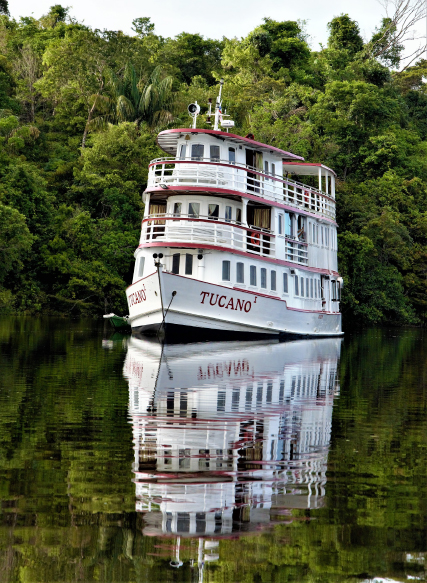
It was all part of experiencing the mystery and magnificence of the Amazon, with 2.5 million square miles of the planet’s lungs, cleaning carbon from the air.
Our adventure-packed trip took us up a long stretch of the mostly uninhabited Rio Negro River in the Brazilian state of Amazonas, where strict conservation measures have dramatically reduced the loss of the rainforest while the fight continues elsewhere.
ON LAND AND RIVER
The full-week journey included a stay at an eco-lodge deep in the rainforest, then cruising north on the Rio Negro on a small riverboat deeper into smaller rivers and on launches to back streams and trails to encounter an encyclopedic gallery of tropical birds, mammals, amphibians, reptiles and plant life.
Amazon Adventures expertly hand-tailored a trip to remember. That included exploring Manaus, a city of 2.3 million people isolated in the middle of the vast Amazon, with a bustling waterfront of wooden riverboats, a teeming Central Market, a magnificent opera house built by rubber barons in the late 1800s and seeing where the dark Rio Negro joins the sandy-colored Amazon River, amazingly flowing side-by-side for almost four miles.
To keep the trip even smoother, we flew into Manaus on Brazil’s GOL Airlines, the only airline with direct flights from Miami, saving us interminable hours dealing with multiple connecting flights.
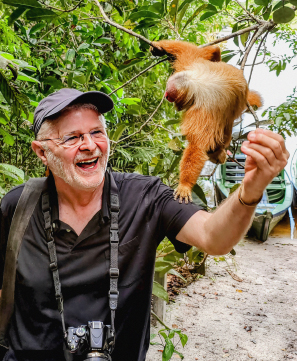
INTO THE RAINFOREST
Our first stay was an hour’s launch ride from Manaus to the rustic-but-comfortable Amazon Ecopark Lodge, where we were soon hand-feeding monkeys at the nearby Primate Rehabilitation Center which re-introduces them to the jungle.
Then it was off to a launch deep into back streams, where we sighted a white heron, brown hawk, and a three-toed sloth and her baby hanging high up in a tree, as well as fishing for piranha, and being surprised by a three-foot reptile leaping up for the dangling bait. “The Amazon is mysterious. Anything can happen anytime,” our native guide Moses told us. “I go into the forest; I say my prayers. I’m a very lucky guy; I see the snakes first!”
NATURE’S SHOW
The next day, we were off by launch to catch up with the shallow-draft riverboat Tucano, already underway from Manaus, for four days and nights exploring the interior rainforest along the Rio Negro.
One of our most lasting memories was experiencing the vastness of the river and the land, with the ship offering a front-row seat for magnificent sunsets and giant black rain clouds miles away over the flat surface, looking for all the world like atomic mushroom clouds.
We had a daily option of four trips on launches—including hiking in the dense rainforest—starting at 6 a.m. and with the last trip at night, with our guide’s search light catching the reflections in animals’ eyes.
There was also time for kayaking, or just relaxing on the canopied top deck, reading, watching the rainforest glide by and chatting with fellow passengers, most heading from or to other parts of South America.
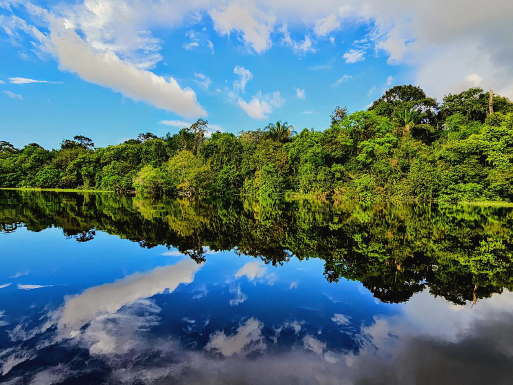
IF YOU GO
The Amazon has two seasons—wet and dry. We went in June at the tail end of the wet season, when the forest was still flooded, but the rain had slowed down. In the dry season, you’ll do more exploring on foot. Either way, the experience is well worth it.
Health Hydrate! It is hot and steamy. Thankfully, the vessel has air conditioning and issues water bottles that were put to good use!
What To Bring Pack quick-drying clothing, including a long-sleeve shirt and long pants for those rainforest hikes. Lightweight hiking shoes are a must. And don’t forget binoculars. Some 70 percent of the wildlife lives in the jungle canopy, with our talented guides amazingly spotting them. A camera is essential plus sun hat, sunscreen, and bug spray
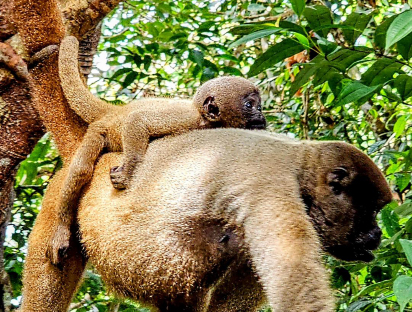
JUNGLE TRAILS
For the afternoon jungle hikes, we were issued wrap-around leather leg gaiters for snake bite protection. Our guide Osmar, who learned “to fish, hunt and survive living with my tribe,” calmly warned us “Walk with your head down. Watch for the snakes!”
The ship’s itinerary is extremely eco-conscious. Don’t expect to swim with captive pink dolphins or visit “native” villages with “costumed” locals posing for photos and selling trinkets. Ship owner Mark Baker stresses ecology in the lectures by the ship’s two guides and with its gravity-operated water system, solar electric generation, and thermal water heating, blending in with its yacht-level wood-lined-and-brass interior.
One of the highlights was fishing for razor-toothed piranha. While others caught a few, I joined the Save The Pirhana Club.

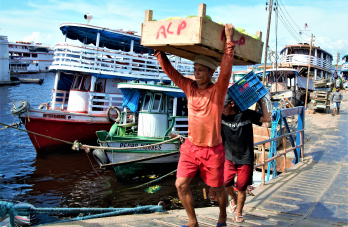
HEAT RELIEF
On the third day, we took a welcome stop for a refreshing swim at a small beach and a visit to a Caboclo (copper-colored) family—river dwelling people of Indian and European heritage—who help hatch baby turtles to protect them from scavenging birds and fish. And that cooling swim felt terrific—with no pirhanas nibbling at my toes!
With our exploration ending all too soon, and back in civilization, we still recall the words of our first guide, Moses, summing up what has become yet one more part of our traveler’s DNA: “The natives believe God is the nature, all put into action,” he told us. “You speak to the forest, and you respect it!”
For more information on Amazon Adventures, visit amazonadventures.com;
GOL Airlines, visit voegol.com;
Amazon EcoPark Lodge, visit amazonecopark.com/br;
Tucano/Nature Tours, visit naturetours.com






